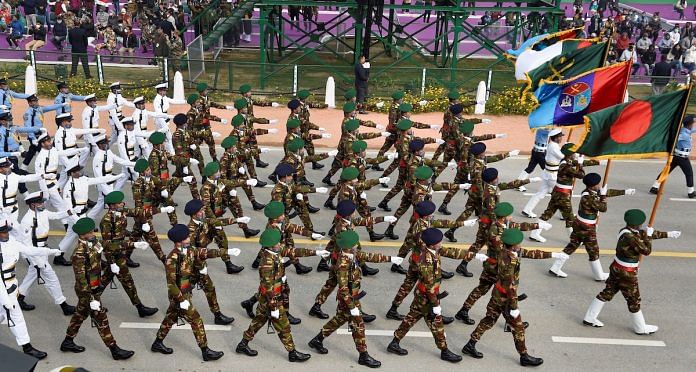The sight of the Bangladesh Army contingent proudly marching down New Delhi’s Rajpath on 26 January is a rare event indeed. Scarcely can anyone believe that it has been 50 years of the liberation of Bangladesh from Pakistani rule. What an occasion to celebrate one of the finest military victories in modern history. Rarely has there been a military campaign like the India-Pakistan war of 1971 in the Eastern theatre.
Both India and Bangladesh are celebrating the Golden Jubilee of that war. The participation in the Republic Day parade is just the beginning of year-long celebrations. The 122-personnel strong contingent comprises soldiers from the units that fought alongside the Indian Army in the war. This is an apt recognition of the role played by the soldiers of both countries in 1971. The 14-day war that resulted in perhaps the largest surrender of an opposing army has few parallels in history. This is also a good time to rethink and recollect the sacrifices of the people on both sides as also the astute leadership of Indira Gandhi and Sheikh Mujibur Rahman. Not only was a young nation born but also the ‘two-nation’ theory torn to shreds forever. Pakistan continues to lick the wounds of this huge humiliation and national disgrace.
Indian Army and Mukti Bahini
The stories of coordination and cooperation between the Indian armed forces and Bangladeshi Mukti Bahini from March 1971 are now part of folklore and the shared history of our two nations. The joyous scenes in the villages and cities of an impoverished people yearning for freedom are hard to forget. Many officers who rose to lead the young country were not only trained but also commissioned in India before the war. I was lucky to get an opportunity to travel across the length and breadth of Bangladesh for a year. I met scores of people with their own tales of how the war started and how it finished with the signing of the Instrument of Surrender by Lt Gen. A.A.K. Niazi and Lt Gen. Jagjit Singh Arora.
Also read: Bangladesh armed forces’ contingent arrives, will join R-Day parade to mark 50 yrs of liberation
Incredible journey of Bangladesh
Not many strategic thinkers and political commentators could have imagined the resilience of the young nation as it was born on 16 December 1971. It was impoverished is an understatement, it was perhaps among the poorest countries in the world at that time. The Pakistani establishment, believing in the inferiority of the Bengali people, scarcely invested any money on its poor eastern half. It held the Bengali people in sheer contempt and considered them unworthy of anything encouraging. At the time of independence, erstwhile East Pakistan had only one officer at the rank of Colonel and probably another handful of officers below that rank. A Pakistani army heavily staffed by Punjabi Muslims, considered Bengalis unfit to fight. It is another fact that once trained by Indian Army, the same soldiers — or the Mukti yodhas — helped turned the tide so rapidly in our favour that a complete psychological dislocation of the Pakistan Army took place.
Surrender to Indian Army
The Pakistan Army agreed to surrender to the Indian Army because they knew they would be given fair treatment as Prisoners of War (PoWs) under the Geneva Conventions. The Mukti Yodha units were all halted at the outskirts of Dhaka till the Pakistan Army completely came under the protection of the Indians. The fear was that if the local people or the Bengali units get anywhere close to them, they would be lynched. The atrocities committed by the Pakistan Army from March 1971 onwards is one of the most gruesome genocides in the history of humankind. So, the Bengalis were baying for their blood and that required the Indian Army to protect them and also give them an honourable exit from Bangladesh.
In the last 50 years, Bangladesh has made a phenomenal journey. Being one of the most densely populated, abjectly poor countries in the world, it has improved in almost all spheres of economy and the Human Development Index. In many areas, it is doing better than its next-door neighbour India and also leaving Pakistan far behind.
India and Bangladesh have seen renewed synergy in all aspects of cooperation. The armies share cordial relations and have a working relationship that far exceeds the formality of defence diplomacy. Officers of both countries attend numerous courses in each other’s training institutions. Both the army chiefs have been invited as chief guests in the Passing Out Parades in each other’s commissioning academies.
Also read: 49 years later, lessons that remain to be learnt from 1971 India-Pakistan War
The Republic Day parade is the harbinger of many new initiatives that India can take to consolidate power in its immediate neighbourhood. Coronavirus vaccination support, mutual aid during natural disasters, combating rogue elements across borders, military training and exercises are other ways to take the India-Bangladesh relationship forward. In the near future, we may see regional military games taking place between the forces of our region.
For now, let’s applaud this particular initiative and cheer the Bangladeshi contingent not only during the parade but at all the places they visit in India. Hope to hear a loud Jai Hind and Jai Bangla as these young soldiers march proudly on the Rajpath in Delhi.
The author is an alumnus of Defence Service Command and Staff College, Mirpur, Dhaka, Bangladesh. Masters in Defence Studies from National University, Dhaka. Views are personal.




Author need to do his homework first before writing about any topic on history. There was a Lt General, One major general, multiple Brigadier general of Bengali origin in the Pakistan army at the onset of the war.
Unfortunately this is the standard for the writeup of an retired General.
Jai Hind! Joy Bangla!
An excellent writeup from a professional soldier.May Bangladesh – India friendship grow from strength to strength.